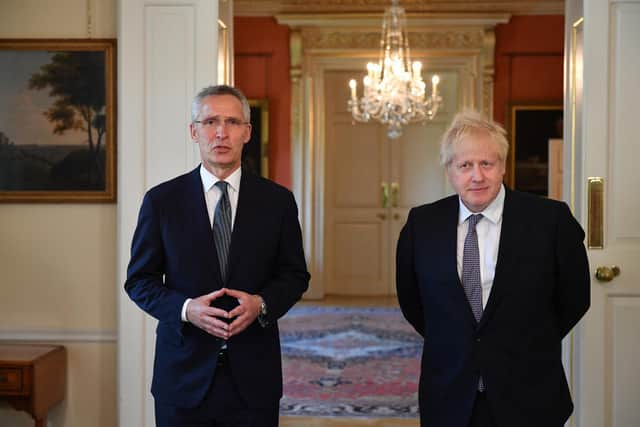NATO Summit 2021: what is the defence alliance, meaning, member countries - and what will happen at meeting?
and live on Freeview channel 276
NATO allies will today meet in-person for the first time since the Covid pandemic began.
The summit, held on Monday 14 June, will see the leaders of the 30 member countries, including Boris Johnson, gather in Brussels as part of the seven-decades-old defence alliance.
Advertisement
Hide AdAdvertisement
Hide AdAll eyes will be on Joe Biden, who will attend the summit for the first time as US President after his predecessor Donald Trump threatened to pull the US out of the alliance three years ago.


The meeting comes after the three-day G7 Summit, which saw leaders of the world’s largest so-called advanced economies descend on Cornwall.
So, what is NATO, who are the member countries - and what will happen at the 2021 summit?
Here is everything you need to know.
What is NATO?
NATO, which stands for the North Atlantic Treaty Organisation, is the world’s most powerful defence alliance.
Advertisement
Hide AdAdvertisement
Hide AdMember countries pledge to spend 2% of their GDP on defence.
It was set up as a military alliance against the Soviet Union in 1949, following World War II, to counter the spread of post-war communism in Europe.
The Soviet Union created a counter-alliance of communist countries called the Warsaw Pact in 1955, but this dissolved when the USSR broke up in 1991.
After the demise of the Warsaw Pact, NATO was left with no obvious purpose and has since used its defensive role to argue that instability in any part of Europe would be deemed a threat to its members.
Advertisement
Hide AdAdvertisement
Hide AdIt has traditionally said its general aim is to "safeguard the freedom, common heritage and civilisation" of its members by preserving "stability and well-being in the North Atlantic area".
Members of the alliance agree that an armed attack against one country should be considered an attack against them all, and that there will be mutual aid if required.
The current Secretary General of NATO is Jens Stoltenberg, former prime minister of Norway, but he is due to step down next year.
Defence Secretary Ben Wallace has recently thrown his support behind former UK Prime Minister Theresa May to be the next NATO chief, saying she would be “excellent” at the role.
Who are the member countries?
Advertisement
Hide AdAdvertisement
Hide AdOriginally made up of 12 member countries, the alliance expanded to include Greece and Turkey in 1952, then West Germany in 1955.
Former Warsaw Pact countries the Czech Republic, Hungary and Poland were the first to gain NATO membership in 1999.
Estonia, Latvia, Lithuania, Slovenia, Slovakia, Bulgaria and Romania were welcomed as NATO members in 2004 in what was a historic step.
The alliance now consists of 30 independent member countries, with the latest nations to join being North Macedonia last year and Montenegro in 2017.
Advertisement
Hide AdAdvertisement
Hide AdThe US still militarily dominates the alliance, as was the case when it was first set up, with the country contributing the most money.
Here’s the full list and the date in which they joined:
| Albania (2009) |
| Belgium (1949) |
| Bulgaria (2004) |
| Canada (1949) |
| Croatia (2009) |
| Czech Republic (1999) |
| Denmark (1949) |
| Estonia (2004) |
| France (1949) |
| Germany (1955) |
| Greece (1952) |
| Hungary (1999) |
| Iceland (1949) |
| Italy (1949) |
| Latvia (2004) |
| Lithuania (2004) |
| Luxembourg (1949) |
| Montenegro (2017) |
| Netherlands (1949) |
| North Macedonia (2020) |
| Norway (1949) |
| Poland (1999) |
| Portugal (1949) |
| Romania (2004) |
| Slovakia (2004) |
| Slovenia (2004) |
| Spain (1982) |
| Turkey (1952) |
| UK (1949) |
| US (1949) |
What will happen at the 2021 summit?
The NATO allies are expected to address the challenges posed by China and Russia during the 2021 summit.
They are also set to make tackling climate change a security priority for the first time.
And the meeting will cover how NATO will transform to deter new defence threats, from cyber attacks and fake news to weapons that can destroy satellites.
Advertisement
Hide AdAdvertisement
Hide AdMr Biden will have a big part to play to repair the relations damaged by Mr Trump, who spent his presidency threatening to quit the alliance and pressuring allies to pay more.
The White House released a statement on Sunday (13 June) setting out key outcomes of the summit in advance.
That included a new “strategic concept” for NATO, which will “guide the alliance's approach to the evolving strategic environment, which includes Russia's aggressive policies and actions; challenges posed by the People's Republic of China to our collective security, prosperity, and values; and transnational threats such as terrorism, cyber threats, and climate change".
NATO will aim to lead the way in “understanding and adapting to the impact of climate change on security", the statement said.
Advertisement
Hide AdAdvertisement
Hide AdAnd NATO chief, Mr Stoltenberg, said during a pre-summit press conference on Friday (11 June): “My ambition is a clear commitment from allies to significantly reduce military emissions and for NATO to contribute to the goal of Net Zero."
Meanwhile, Boris Johnson is to highlight the importance of security as the world seeks to rebuild from the Covid pandemic.
Comment Guidelines
National World encourages reader discussion on our stories. User feedback, insights and back-and-forth exchanges add a rich layer of context to reporting. Please review our Community Guidelines before commenting.
